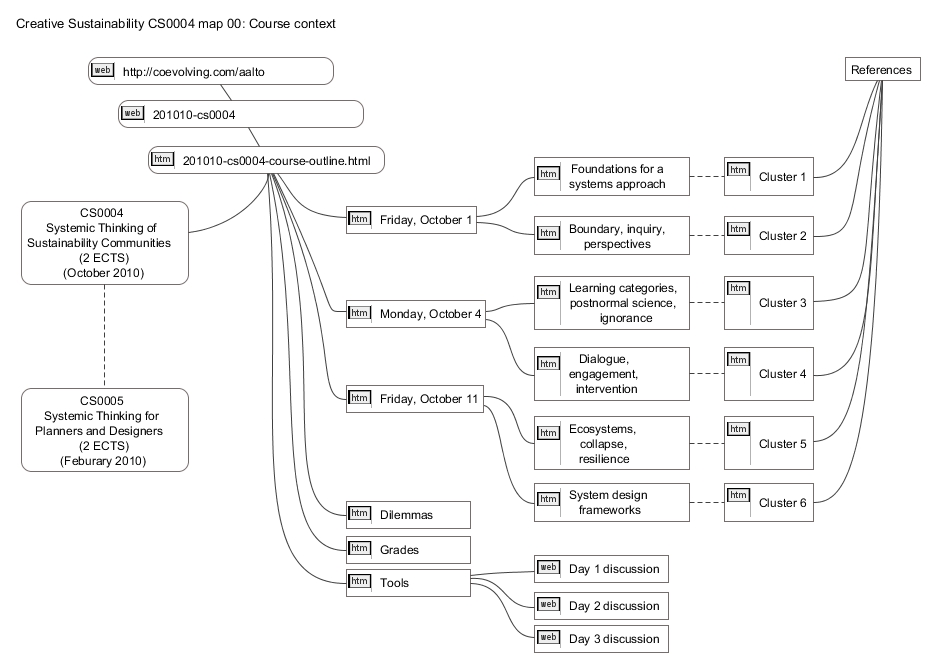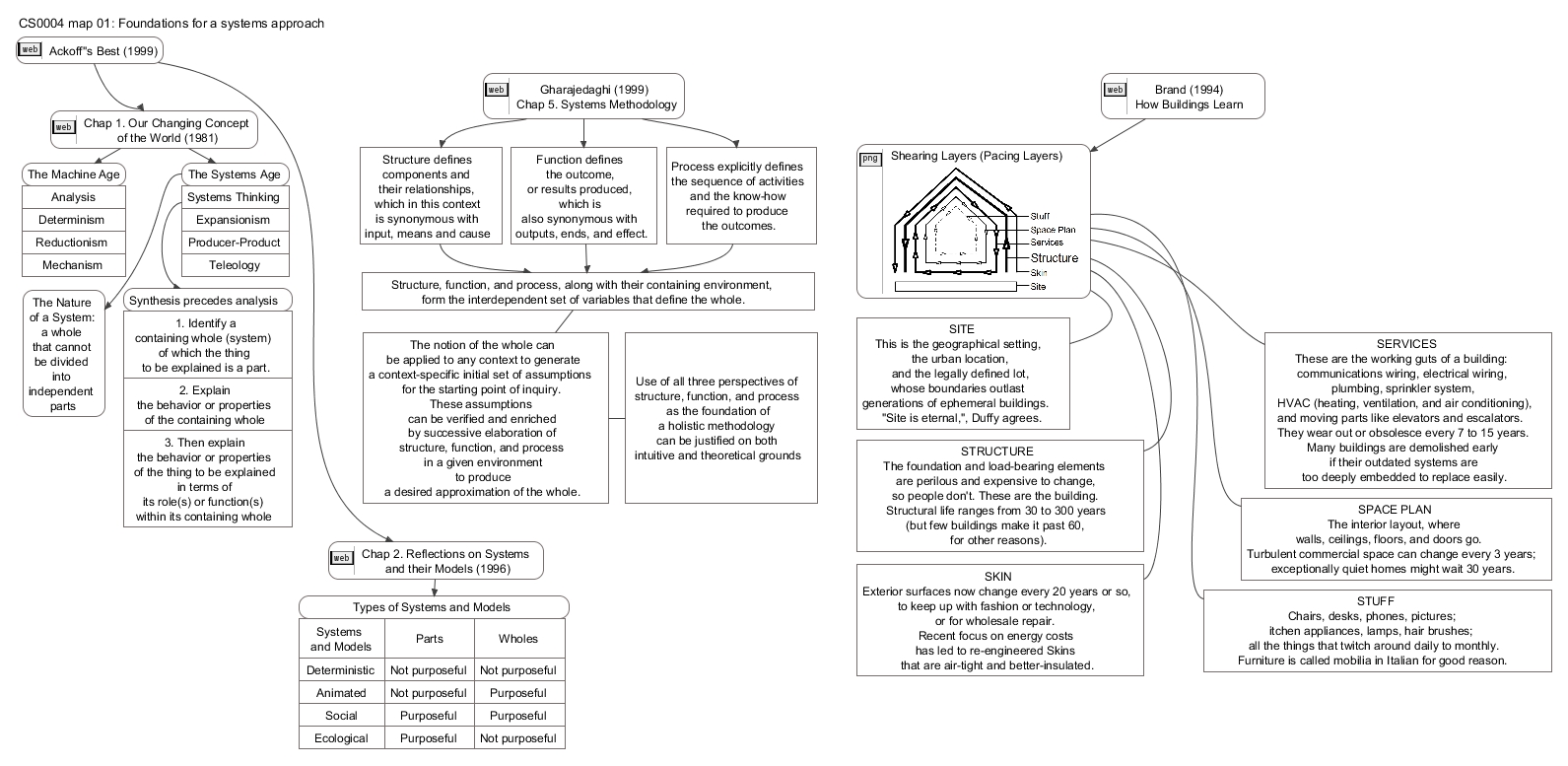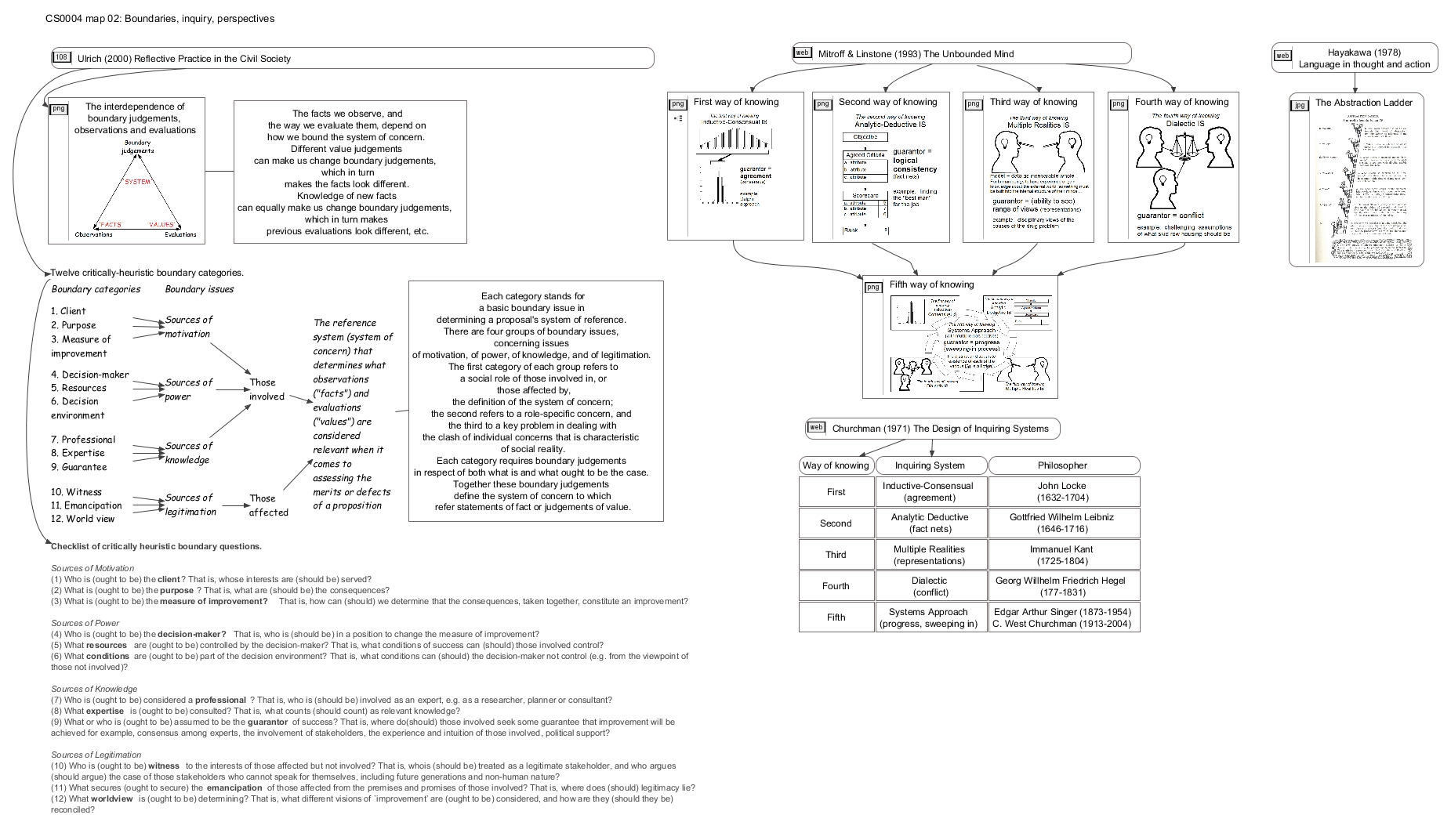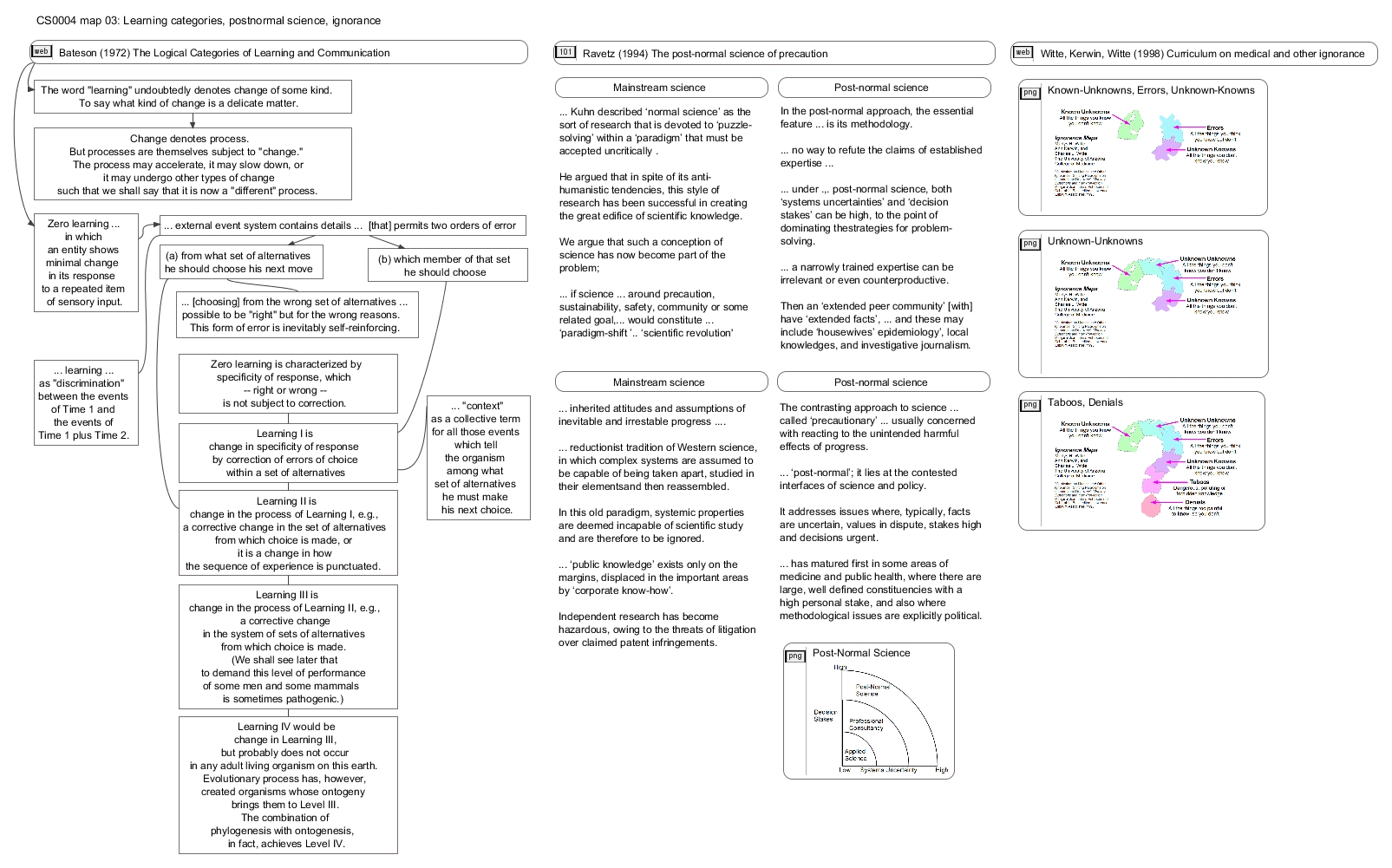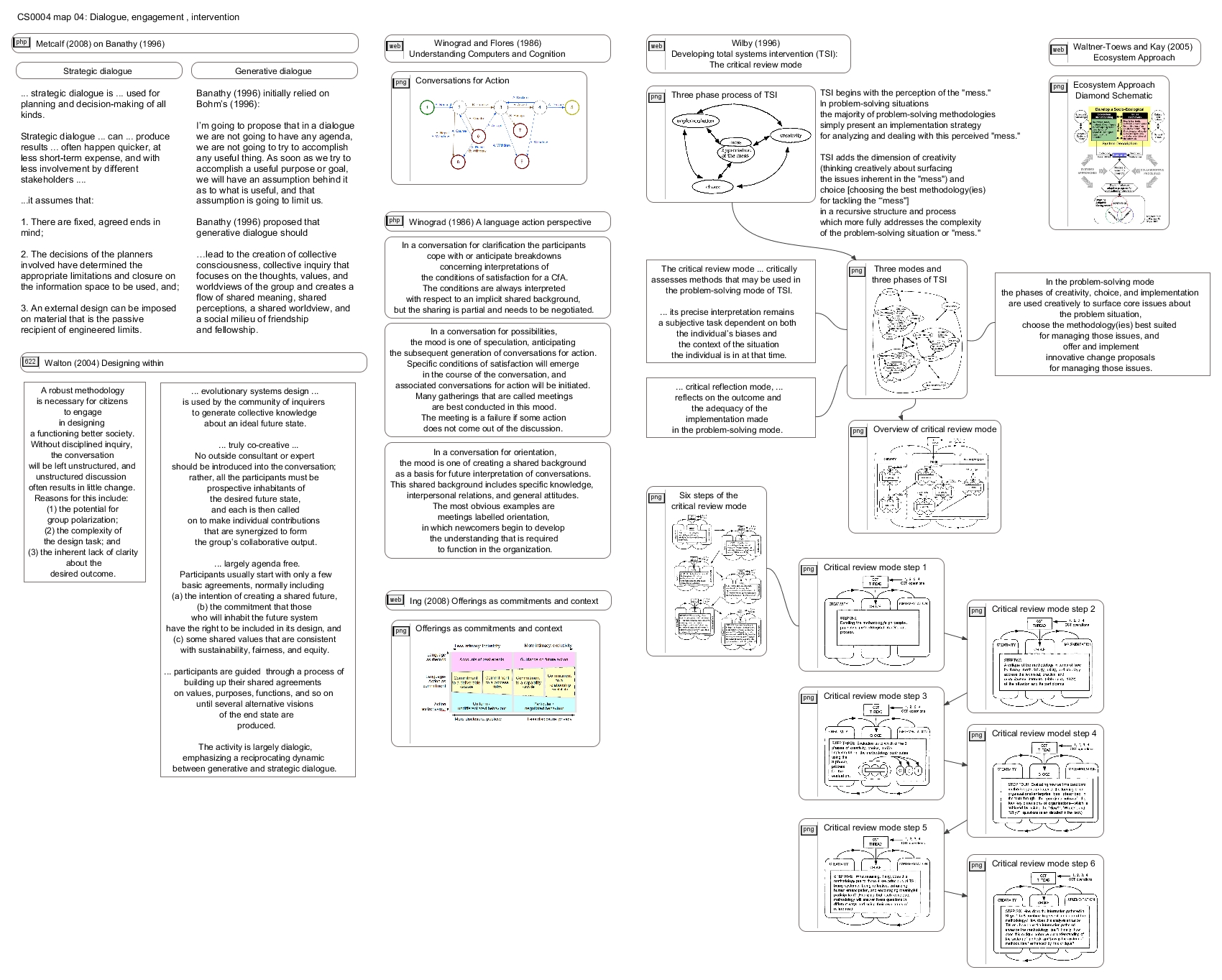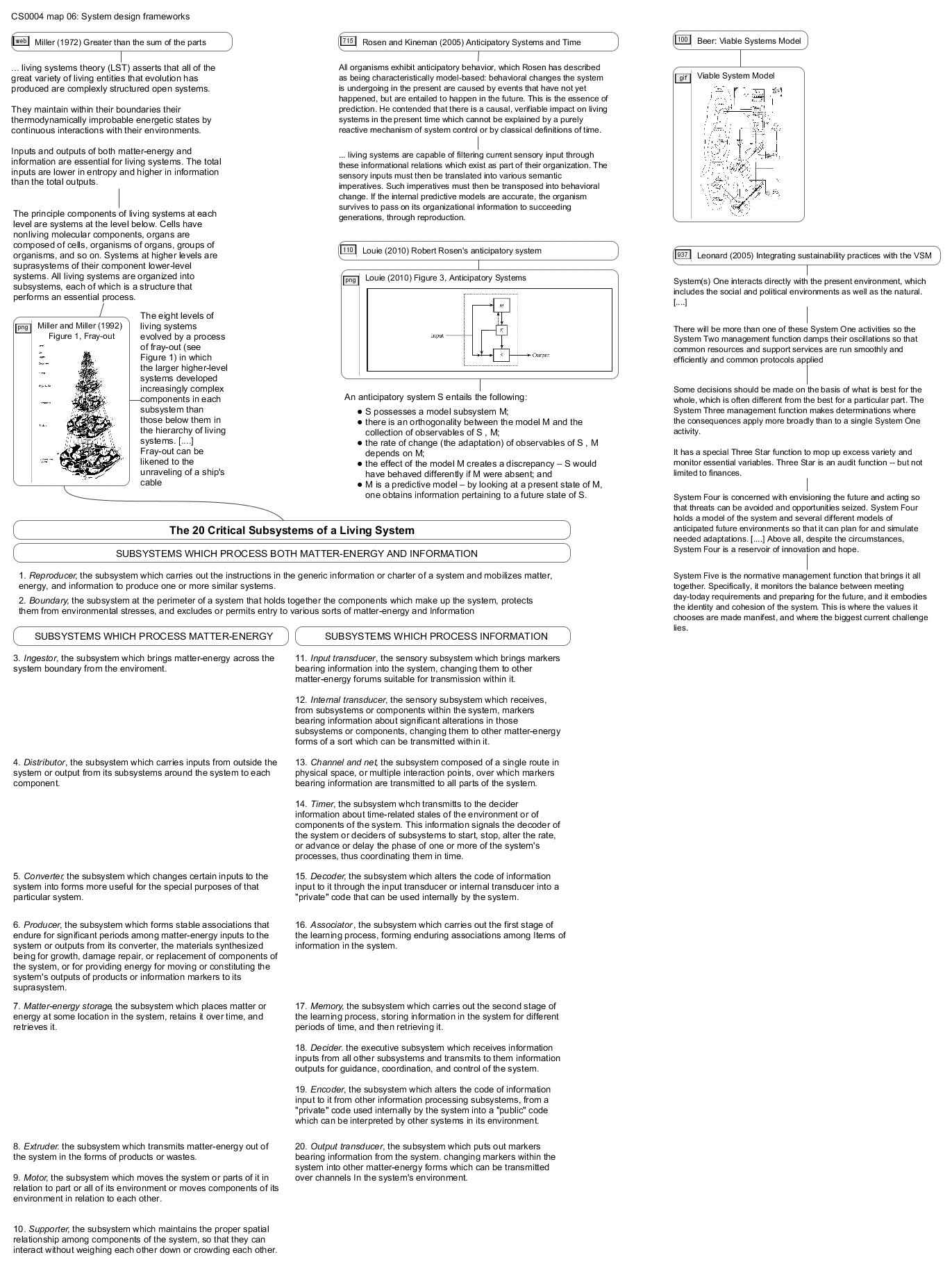[Frank] Oppenheimer had a provocative approach to learning, which can be summarized by saying that …
the best way to learn is to teach, the best way to teach is to keep learning, and that what counts in the end is having had a shared, reflected experience. (Delacote, 1998)
At the beginning of October, I had blogged about starting the first of two courses in the master’s program in Creative Sustainability at Aalto University. I’ve been maintaining the content online as open courseware, and have now added an index page. The context map and the course outline have evolved, and should now have mostly stabilized with the conclusion of the lectures.
The course isn’t quite done yet, as the students have to write research papers. I took responsibility for the course content, and Aija Staffans and Katri-Liisa Pulkkinen have taken responsibility for guiding the students through the university practicalities and evaluating their learning.
While I have previously instructed at the master’s and doctoral level before, I don’t claim to be the greatest teacher. I see myself as a researcher who can share content with students, whom may have more or less interest in the topics. Teaching this first class on Systemic Thinking of Sustainable Communities (with a follow on of Systemic Thinking for Planners and Designers scheduled five months later) has led me to some of my own learning, with overall conclusions that include:
- 01. Sustainability is a topical theme that can be complemented by the systems sciences
- 02. Designing for dialogues about future systems is distinct from designing future systems that will learn
- 03. Open courseware is a foundation, and not a replacement for teaching
- 04. Education on systems thinking from a systems sciences approach should include both theory and method
- 05. Today’s students are comfortable with online materials, social communities and blogging
Having the course materials available on the Internet allowed me — with sufficient warning to students that they should check revision dates on documents — a luxury to revise materials just before the lectures … and following the lectures. Thus, there are some specific learning on each of the content for each lecture:
- 06. Map 01: Foundations for a systems approach
- 07. Map 02: Boundaries, inquiry, perspectives
- 08. Map 03: Learning categories, postnormal science, ignorance
- 09. Map 04: Dialogue, engagement, intervention
- 10. Map 05: Ecosystems, collapse, resilience
- 11. Map 06: System design frameworks
My reflections are expanded, below.
01. Sustainability is a topical theme that can be complemented by the systems sciences
Some people deep into “systems thinking” have become vocal evangelists that the systems perspective is often missing in policy-making, research and education. I have a more pragmatic view that the disciplinary sciences are sufficient for most situations in our everyday lives, with the systems sciences bringing greatest value when interdisciplinary (or transdisciplinary) engagement is needed. The systems approach is a means, not an end.
The domain of sustainability is a mess — more formally, a problematique, or a system or problems. Allenna Leonard says that when dialogues cross disciplines, the conversations often revert to the lowest common denominator amongst participants — as low as the level of a Grade 6 education. The systems approach can provide a higher level of language, concepts, theory and method applicable by both the learned and the layman. While I point out more formal definitions for systems foundations (i.e. whole, part, function, structure, process) to clarify classroom discussion, most people shouldn’t find these ideas too foreign.
In the mess that is sustainability, I’ve attempted to be humble in the scope of my expertise. I know quite a lot about the systems approach, I’m better than a layman in appreciating the issues of sustainability, and I rely a lot on the research of ecologists who also systemicists (e.g. panarchy from the Resilience Alliance).
02. Designing for dialogues about future systems is distinct from designing future systems that will learn
The decision to have two courses on systems thinking — one focused on communities, and the other focused on planners and designers — had been made well before I arrived on the scene. This split has turned out to be advantageous to learning, as the orientations can be differentiated.
In contemporary parlance, the community orientation follows the “wisdom of crowds“, whereas the planners’ and designers’ orientation follows the expertise of accomplished and extraordinary people (e.g. “outliers“). In a systems approach, this parallels (i) one stream emphasizing towards dialogue, conversation and participatory design, and (ii) another stream emphasizing purpose, planning and modeling. In the real world, both perspectives are simultaneously in practice. In a teaching situation, recognizing distinctions in the underlying philosophy is educational.
One challenge that we encountered in the classroom was a predisposition towards pursuing a design for an outcome, rather than design of a process (i.e. the way that dialogue and conversation is conducted). This predisposition was partially attributed to the large number of students from a design (e.g. product design) background, but I think there’s a deeper issue at play. Our society may have become so results-oriented that any activity that isn’t guaranteed to produce a predefined outcome (e.g. consensus) may be perceived as incomplete or unfocused. The alternative outcome where parties “agree to disagree” — potentially resulting in two systems coexisting in harmony, rather than a single system with continuing counterproductive conflict — may not be allowed to emerge.
This challenge will likely be the greatest influencer in evolving the next version of the course (probably October 2011).
03. Open courseware is a foundation, and not a replacement for teaching
In the summer preceding the launch of the new course, I browsed through recent issues of systems journals (e.g. Systems Research and Behavioral Sciences, Systemic Practice and Action Research) to create the reading list, supplemented by some of the standard works (often books) that are well-known in the systems community. This resulted in a list of references that I cautioned Aija and Katri would be implausible for any individual human being to digest. This list has evolved into the course outline, with directions to the students to pick ideas they like (or choose readings randomly) in the hope that there might be some peer-learning across the class. Electronic access to journals has made finding articles as simple as following through the DOI link (sometimes!), and a preview on Google Books can give the student a sense of whether a trip to the library will or won’t be worthwhile.
While I’m proficient in creating slideware (e.g. Microsoft Powerpoint, Lotus Symphony Presentations), there’s downsides with linear sequentiality that I don’t find in visual maps. I’ve recently been creating maps with selected diagrams and text excerpts using the Visual Understanding Environment, which has the advantages of being available as open source and following web standards well. The network structures depicted on those visual maps help the students to orient themselves on the content, with scrolling the window an alternative to jumping slides.
The class size of 27 students was great for lectures that ran from 45 to 90 minutes in length. Watching the faces of students, I could see when a point was resonating and when the idea was difficult. I tried to take questions in the flow of the lecture, and we could have had much more interaction if we had had more time. One of the teaching decisions that I had to make on the fly was balancing breadth versus depth of content. The original publications were cited and generally available, so unanswered questions were an invitation for each student to pursue his or her own curiosity for greater detail … again acknowledging that no single individual will be able to know everything.
04. Education on systems thinking from a systems sciences approach should include both theory and method
I see systems thinking as an art that is not necessarily incompatible with the rigour of the sciences of systems. I find some courses — in a zeal to be “more practical” — oriented too far towards systems methods (i.e. how-to approach issues from a systems approach) leaving insufficient attention to be paid on systems theory (i.e. models or representations of the world that are generally accepted as true). While familiarity with specific tools and techniques might be immediately gained, I suspect that students don’t get the appreciation for why one method might be preferred over another (and ways in which those methods might be misused).
I believe that students will respond to theory if the question of “why should I care?” is answered. Connecting the abstract ideas to practical situations and concrete stories improves relevance and understanding. The orientation towards science does require that the content reflect the current state of knowledge (e.g. recent journal publications). Many luminaries in the systems movement have passed on, so while the knowledge that they’ve preserved in their writings and presentations may be respected, I would think that those luminaries would be distressed if the systems sciences ceased to continue to develop.
These statements are made from the perspective of an instructor for a course taught at the master’s level. Further, my experience with students in Finland has shown that they are not intimidated by assignments of readings from scientific journals, and they value real knowledge. This seriousness is not necessarily the style in North American pedagogy. Since there is a wealth of material available online, I suggested to student that they might read an article quickly, and seek alternative publications by that same author if the writing was found to be too difficult. The vagaries of reviewing processes sometimes make an article more convoluted than would be a presentation directly by that researcher.
05. Today’s students are comfortable with online materials, social communities and blogging
I have a distaste for student assignments that are written solely to be read by an instructor, and no one else. Thus, I’m an advocate not only of online writing (e.g. blogging), but also venues where the world can access knowledge (i.e. without passwords or private registration).
In the first session with this class, I asked how many students were already writing blogs. Zero hands went up. I then asked how many were on Facebook, and all of the hands went up. We then followed through on plans to have students (i) sign up for their own blogs (e.g. they’re free on wordpress.com, and some students have their own web sites), and (ii) coordinate activity through microblogging on the Systems Community of Inquiry. The Facebook-wall style of date-oriented posts works — the interface might be busy for people prefer more concise interfaces — and some order has been established with separate forum threads for Day One, Day Two, Day Three, and the Final Research Report.
On the more formal activities of writing, I’ve been informed that these master’s students (particularly the ones from a design background) may not be used to writing articles in an academic style. Aija and Katri believe that this is a skill that master’s students should develop, so I expect that students may need some coaching on form as well as content. I’ve relayed my positive experiences with using Zotero as a Firefox plugin to ease some of the issues with getting the correct formatting of references.
Having reflected on course as a whole, I’ll now describe the learning that occurred in preparing each of the lectures.
06. Map 01: Foundations for a systems approach
The first lecture started with basic definitions, from Ackoff and Gharajedaghi.
During the class, the discussion led to my drawing Stewart Brand’s shearing layers (or pacing layers) model on a flipchart. After the class, I added this content to the map.
07. Map 02: Boundaries, inquiry, perspectives
In the lecture, I referenced Ulrich’s views on boundary judgement, and covered the design of inquiring systems by Mitroff & Linstone as well as Churchman.
As a result of some struggles in the exercises in dilemma groups, I fleshed out Ulrich’s boundary categories to a deeper extent, as well as suggesting that more progress could be made by stepping down to the concrete, in Hayakawa’s abstraction ladder.
08. Map 03: Learning categories, postnormal science, ignorance
The learning categories by Bateson, post-normal science by Ravetz, and map of ignorance by Witte, Kerwin and Witte fit together well, and students got the idea easily.
In the exercise that followed, there were questions about how to design for unknown-unknowns … which meant that the students were thinking.
09. Map 04: Dialogue, engagement, intervention
Walton’s description of Banathy, the language-action perspective from Winograd and Flores, and the ecosystem approach by Waltner-Toews and Kay were in the original reading list.
Just before class, Metcalf’s description of Banathy provided a conside source on generative dialogue and strategic dialogue. Wilby’s critical review mode filled out the thinking on Total Systems Intervention from Flood.
10. Map 05: Ecosystems, collapse, resilience
Starting with collapse as described by Tainter drove reflection on the negative state that sustainability aims to avoid. This led naturally to Tim Allen’s work on supply-side sustainability and gain in ecology. Holling’s work on resilience and panarchy followed naturally on this lecture.
The addition of Elinor Ostrom — as a Nobel Prize laureate — provided additionally legitimacy for the panarchy work extending into political economy.
One addition that I’ll need to make for next year is a better explanation of the economic concepts of marginal benefit and marginal cost, as used by Tim Allen. I wasn’t expecting to have to give an ECON 100 lecture, but there’s no reason for any of the students in this class to have had studied that content.
11. Map 06: System design frameworks
Opening up a time slot for students to give brief summaries of their class exercises meant that the final lecture could only outline Miller’s Living Systems Theory, Rosen’s Anticipatory Systems, and Beer’s Viable System Model.
This content is actually more appropriate for the designers and planners course than the communities course. A year from now, perhaps I’ll replace these models with concrete approaches to facilitating conversations.
I’m looking forward to the second course in February, when I’ll cover the perspective of planners and designers, and learn some more about teaching systems.
References
Delacote, Goéry. 1998. Putting Science in the Hands of the Public. Science 280, no. 5372 (June 26): 2054-2055. doi:10.1126/science.280.5372.2054. http://dx.doi.org/10.1126/science.280.5372.2054.

